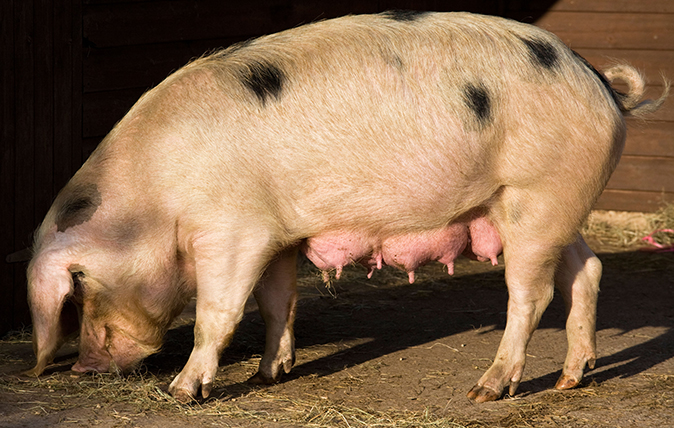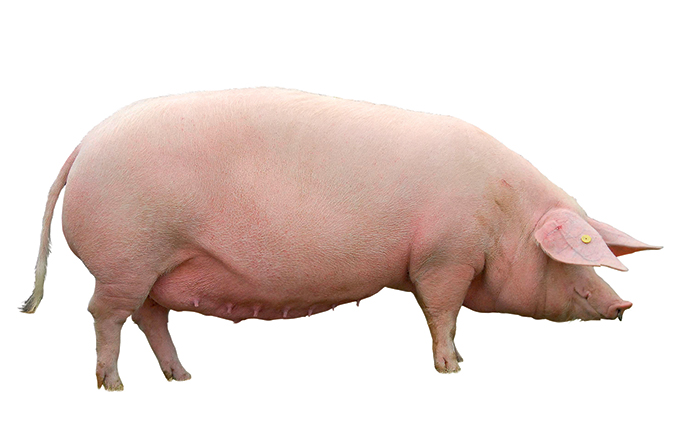Top native pig breeds
Our traditional pig breeds are a delight to look at and tasty to eat - which is your favourite?


Britain's traditional pig breeds are a delight to look at and delicious to eat
Tamworth
The russet-coloured Tamworth was started by Sir Robert Peel, founder of the police force, on his Drayton Manor estate in Staffordshire. Its prick-eared, more streamlined form is closest to that of the original forest pig because it hasn’t been ‘improved’, partly due to being too far from the ports into which Asian breeds were arriving.
David Wilson, Prince Charles’s farm manager at Highgrove, describes them as ‘the PhDs of pigs’ and they gained a reputation, perhaps unfair, for escapology in 1998, when the ‘Tamworth Two’, Sundance and Butch, spent a week on the run after absconding from a Wiltshire abattoir. Tamworth Breeders’ Club (07879 697792; www.tamworthbreedersclub.co.uk)

Gloucester Old Spot
The stately, deep-bodied pink Gloucester Old Spot is in better shape than some other breeds—it’s listed as ‘minority’ (500–1,000 breeding sows)—and was the first to be accorded EU Traditional Speciality Guaranteed status for the quality of its meat. Owners include The Prince of Wales, Liz Hurley and The Princess Royal, who is president of the breed society.
Rare-breed enthusiast Jonathan Crump keeps six grazing the Gloucestershire farm owned by the singer Sade. The farm overlooks the Berkeley vale where the breed originated; nicknamed the ‘orchard pig’, legend has it that its spots were bruises caused by falling apples. Gloucester Old Spot Pig Breeders’ Club (01507 533209; www.oldspots.org.uk)
Exquisite houses, the beauty of Nature, and how to get the most from your life, straight to your inbox.

Berkshire
The Berkshire is known as ‘the ladies’ pig’ for its sweet nature and manageable size—Queen Victoria was an enthusiast, as was Beatrix Potter, who owned Pig-wig, the inspiration for Pigling Bland’s cohort, and the dish-faced, snub-nosed pig with its smart white socks, snout and tail was popular with the Victorian aristocracy.
There are references to Cromwell’s forces being fed on tasty bacon from local pigs in the reading area, but the Berkshire as we know it didn’t take shape until about 1825, when Lord Barrington began improving his large, spotted tawny pigs with smaller Asian lines. An extra layer of fat gives Berkshire meat extra flavour—it’s considered a delicacy in Japan. Berkshire Pig Breeders’ Club (01772 673245; www.berkshirepigs.org.uk)

British lop
The lugubrious pig looks wonderfully old-fashioned, which is perhaps why it’s categorised as vulnerable (there are fewer than 220 breeding sows left in the world) and is rarely seen out of the West Country. It suffered grievously from the Ministry of Food’s postwar instruction to shun it; in a 10-year period in the 1960s and 1970s, only 105 boars and 222 gilts were registered and a mere 11 breeders were keeping the pig alive. Defra’s Farming Minister George Eustice and his brother, Giles, own the UK’s largest herd, dating back to the 1890s, at their Cornish farm, Trevaskis, Hayle, and, last year, backed the breed society’s Love a Lop campaign. The lop’s moist and creamy meat and ability to survive on rough land makes it ideal, Giles says, for ‘crossing the boundary between a rare breed and a commercial one’. British Lop Pig Society (01579 370503; www.britishloppig.org.uk)

British saddleback
The 19th-century landowner and Whig politician Lord Western was on a Grand Tour when he spotted some Neapolitan pigs in Italy and fancied crossing them with his Essex sows. Today’s magnificent pig, black with a white band, is an amalgam of the Wessex saddleback and the Essex pig—the two breed societies merged in 1918 and the herd books in 1967. During the Second World War, these hardy breeds, neither of which feature any Chinese blood, accounted for 47% of all sows. However, like the large black, the saddleback became overlooked in the rush for white pigs and it’s now classified as ‘at risk’ by the RBST. British Saddleback Breeders’ Club (01403 783849; www.saddlebacks.org.uk)


Oxford sandy and black
The spotted orange Plum Pudding or Oxford Forest pig is arguably the most attractive of all, but it nearly became extinct twice; in the 1940s, numbers of registered boars sank to one a year, partly because it lacked its own society until 1985. The pig has existed for up to 300 years, but is now listed as at risk, even though admirers describe it as a quick-finisher, biddable and economical to keep, making it ideal for smallholders and novice hobby farmers. Converts include Lord Gerald Fitzalan-Howard at Carlton Towers, North Yorkshire, where he’s begun breeding them for the cookery school. Oxford Sandy & Black Pigs Society (07971 551313; www.oxfordsandypigs.co.uk)

Large black
Imposing but sweet-natured, this is Britain’s only all-black pig, thought to be a mix of old English hog and the Chinese black pigs that arrived by ship in Cornwall and East Anglia in the 18th century. The breed society was formed in 1889 and the splendid-looking animals were at the height of their popularity in the early 20th century, when one was supreme champion at Smithfield in 1919, selling for 700 guineas, and the animals were widely exported because they’re less susceptible to sunburn. By the time the RBST started in 1973, there was a pervading prejudice against black pigs and the breed was on the critical list (it’s now vulnerable), despite the fact that the pig kills out white— there’s no black rind on its bacon, which is excellent. It’s a good breeder—one poor sow is listed in the Guinness Book of Records for producing 26 litters between 1940 and 1952. Large Black Pigs Breeders’ Club (01619 764734; www.largeblackpigs.co.uk)
Kate is the author of 10 books and has worked as an equestrian reporter at four Olympic Games. She has returned to the area of her birth, west Somerset, to be near her favourite place, Exmoor. She lives with her Jack Russell terrier Checkers.
